
The red RFsThis page created 28th December 1997, updated 7th February 2002.The Central Area buses: 2RF2/2RF 289 - RF 513, or RF 314 - RF 532/8, Total 225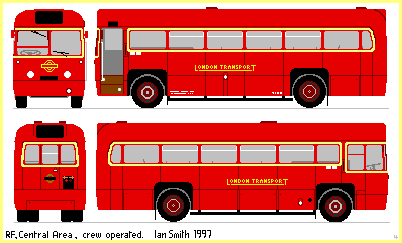 The Central Area's red RFs were all of the longer, 30ft, variety.
They differed from the Green Line RFs most obviously in having no doors at the front,
at the insistence of the Metropolitan Police
(who seemed more concerned at possible delays to traffic than at the risk to the public).
They were also red, of course, with the trim picked out in cream.
Above the entrance door there was a block to hold a route number stencil.
Internally the seating was arranged to give a standing/circulating area at the front,
with sideways-facing seats over the front wheel arches:
for four behind the driver, and five on the nearside.
The other seats were spaced slightly more closely than on the GreenLine version,
giving a total seating capacity of 41, with five standing allowed.
Alternate rows of seats had handrails to the ceiling,
reflecting the increased passenger movements in the urban bus compared with the semi-fast coaches.
The Central Area's red RFs were all of the longer, 30ft, variety.
They differed from the Green Line RFs most obviously in having no doors at the front,
at the insistence of the Metropolitan Police
(who seemed more concerned at possible delays to traffic than at the risk to the public).
They were also red, of course, with the trim picked out in cream.
Above the entrance door there was a block to hold a route number stencil.
Internally the seating was arranged to give a standing/circulating area at the front,
with sideways-facing seats over the front wheel arches:
for four behind the driver, and five on the nearside.
The other seats were spaced slightly more closely than on the GreenLine version,
giving a total seating capacity of 41, with five standing allowed.
Alternate rows of seats had handrails to the ceiling,
reflecting the increased passenger movements in the urban bus compared with the semi-fast coaches.
Into service They went into service from 10th September 1952,
replacing TDs and 6Q6s on the hilly 210 route in north London, operating from Muswell Hill (MH).
Next to be replaced were LTL "scooters" on the 208A (Dalston, D) and 227 (Bromley, TB).
They went into service from 10th September 1952,
replacing TDs and 6Q6s on the hilly 210 route in north London, operating from Muswell Hill (MH).
Next to be replaced were LTL "scooters" on the 208A (Dalston, D) and 227 (Bromley, TB).
More LTLs went from Hounslow (AV), on the 237, a route which earlier had been served by diminutive 20-seater Dennis Darts. The next round of RF placements initiated a complex shuffle: RFs went to Old Kent Road (P) for the 202, and to Merton (AL) for the 200. This allowed their 5Q5s to go to Sidcup, from where postwar 14T12s went to Southall, allowing their TDs to go to Kingston (K) to displace 4Q4s for scrap! RF350 on the 227, at Crystal Palace
|
| Dates | Route No | Route | Garage | Displaced types |
|---|---|---|---|---|
| Sept, Oct 52 | 210 | Finsbury Park-Golders Green | MH | TD |
| October 1952 | 208A | Maryland Stn-Clapton Pond | D | LTL |
| Nov, Dec 52 | 227 | Chislehurst-Penge | TB | LTL |
| December 1952 | 237 | Hounslow-Chertsey | AV | LTL |
| December 1952 | 200 | Wimbledon Stn-Coombe Lane | AL | 5Q5 |
| December 1952 | 202 | New Cross-Canal Bridge | P | 5Q5 |
| Dec 52, Jan 53 | 213 | Kingston-Belmont | NB | 14T12 |
| January 1953 | 234A | Purley-Hackbridge | TC | LTL |
| January 1953 | 208 | Bromley-by-Bow-Clapton Pond | D | LTL |
| January 1953 | 228 | Chislehurst-Well Hall Stn | SP | 14T12 |
| February 1953 | 233 | Finsbury Park-Northumberland Park | WG | 5Q5 |
| February 1953 | 208 | Bromley-by-Bow-Clapton Pond | D | 5Q5 |
| February 1953 | 212 | Finsbury Park-Muswell Hill Broadway | MH | 1TD1 |
| March 1953 | 241 | Welling Stn-Sidcup Garage | SP | 5Q5 |
| October 1953 | 254 | Loughton Stn-Buckhurst Hill | L | 5Q5 |
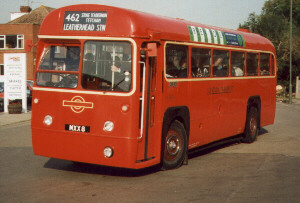 As the RFs settled into work, they were noticeably faster than their predecessors.
This allowed some reductions in numbers of buses allocated to some routes,
as schedules were adjusted,
and so Loughton received an allocation of RFs to replace TDs.
These were stored for a while, then replaced 14T12s at Norbiton, these last being sold.
As the RFs settled into work, they were noticeably faster than their predecessors.
This allowed some reductions in numbers of buses allocated to some routes,
as schedules were adjusted,
and so Loughton received an allocation of RFs to replace TDs.
These were stored for a while, then replaced 14T12s at Norbiton, these last being sold.
(RF 366 at Cobham Station, operating a service on the 1997 RF Running Day.
This RF has been equipped in preservation with semaphore indicators.
The slot can be seen behind the doorway.
Photo by Ian Smith. Click on image for larger version.)
The 1955 survey of fleet requirements showed a considerable extra need for Green Line RFs, while the Central Area was deemed to have surplus single-deckers. So after some bitter wrangling Central Area was forced to give up ten of the Private Hire RFs and six buses. The latter were converted to Green Line specification, with doors, luggage racks, extra lighting and revised seating.
In order to keep the numbers of RFs in tidy blocks by usage, the buses converted were the first six numerically, RF289-294 (MLL926-931). But 19 Country buses were also being converted, so the next nineteen Central buses (RF 295-313) were renumbered to the end of the Central bus block, becoming RF 514-532.
But that was not the end of the argument. Central Buses were incensed at losing modern RFs when they still had old-fashioned (if not terribly old) 14T12s and 1TD1s to operate. The trades unions considered it a grave breach of faith, and threatened industrial action. Central Area won back six buses, which were extracted from Country Area and sent to Sidcup complete with doors and green livery. (Six red RFs went on to Muswell Hill, displacing TDs on the 251) Another twelve green RFs were borrowed by Central Area to cover during the 1956-7 overhauls, and these too were allocated to Sidcup, which therefore had a total of 18 green RFs for a year or so!
(Meanwhile Kingston borrowed three (or four) 15T13s from the Country Area - but that isn't really part of this story!)
| Old numbers | Old type | Work done | New numbers | New type |
|---|---|---|---|---|
| RF 289-294 | Central Bus | Repaint, doors, roofboards, lights, lino, seats, racks | RF 289-294 | Green Line |
| RF 295-313 | Central Bus | renumber only | RF 514-532 | Central Bus |
| RF 533-538 | Country Bus | transferred (still green) | RF 533-538 | Central Bus |

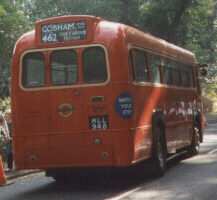
RF 530, one of the re-numbered Central Area RFs, on duty at the 1997 RF Running Day, Cobham. Click for larger images.
Re-deployments
In 1958 Sidcup lost its RFs when Sidcup station bridge was rebuilt, allowing RT operation of the 228 and replacement of the 241 by RTs on an altered route 51. The RFs from Sidcup (all red by now), were allocated to garages still operating 14T12s: Uxbridge (222), Southall (211), Leyton and Tottenham (236), eliminating the type from service.Three more spare RFs were found early in 1959 to allocate to Norbiton for the 201, allowing Central area to send back the three green 15T13s to the Country Area.
Meanwhile, Old Kent Road garage had closed, so that its RF allocation for the 202 went to New Cross (NX).
Summary of re-allocations 1956-59:
| Dates | Route No | Route | Garage | Displaced types | Replacements |
|---|---|---|---|---|---|
| December 1956 | 251 | Arnos Grove-Burnt Oak | MH | TD | RF |
| November 1958 | 228 | Chislehurst-Well Hall Stn | SP | RF | RT |
| November 1958 | 241 | Welling Stn-Sidcup Garage | SP | RF | RT (on 51) |
| December 1958 | 222 | Hounslow Central-Uxbridge | UX | 14T12 | RF |
| December 1958 | 211 | Ealing Broadway-Greenford | HW | 14T12 | RF |
| December 1958 | 236 | Leyton (High Road)-Stroud Green | T/AR | 2TD2 | RF |
| January 1959 | 201 | Kingston - Feltham | NB | 15T13 | RF |
One Man Operation?
The London Transport Board proposed to extend one-man-operation of single deck buses to the Central Area, and in preparation for this started a programme of conversions to RFs. The single-man versions were to have doors fitted, plus a reversing light and cab modifications, as on the OMO Country versions.Routes identified for OPO conversion were the 216, 218 and 219, all operated by Kingston with TD2s. Enough RFs were found by pulling together the rest of the Sidcup allocation, converting West Green's route 233 to RTL operation, and altering the 208 to the 178 with RLH buses.
But the Unions wouldn't play. Whereas the Country Area had an existing OPO agreement, the Central Area had had no OPO working since Central's Leyland Cubs disappeared in 1949. Negotiations stalled.
Meanwhile Central RFs 502 to 538 were converted.
They were stored for a while,
then deployed as crewed buses to eliminate other pockets of TD operation,
from North Street (250), Uxbridge (224,A,B) and Norbiton (206 and 264).
The 216 from Kingston was also converted from TD operation to crewed RF.
Five of the red OMO RFs were loaned to Reigate (RG) in the Country Area,
during the summer of 1959, for use on the 447, releasing further Country RFs for conversion.
RF 534, seen at the 1997 RF Running Day, at Cobham station. RF530 at North Weald Rally in June 1998.
Both RFs were converted for OPO in April 1959, and RF530 wears the blinds for the non-OPO route 250 where it was diverted.
As one of the last survivors in service RF534 acquired the white bullseye livery when re-certificated in 1976.
RF530, on the other hand, still wears original livery in preservation.
Photos by Ian Smith. Click on images for larger version.
Summary of the 1959 re-allocations:
| Dates | Route No | Route | Garage | Displaced types | Replacements |
|---|---|---|---|---|---|
| March 1959 | 233 | Finsbury Park-Northumberland Park | WG | RF | RTL |
| May 1959 | 208 | Bromley-by-Bow-Clapton Pond | D | RF | RLH (178) |
| June 1959 | 224,A,B | Uxbridge-Laleham | UX | 2TD2 | RF |
| June 1959 | 206 | Claygate-Hampton Court Stn | NB | 2TD2 | RF |
| June 1959 | 264 | Sunbury - Hersham | NB | 15T13 | RF |
| July 1959 | 250 | Hornchurch-Epping | NS | 14T12 | RF |
| July 1959 | 216 | Kingston - Sunbury - Staines | K | 15T13 | RF |
At about this time the entire RF fleet was equipped with "trafficators",
direction indicators mounted on swivels at the front cant rail level of the buses.
In conjunction with this they had the double-headed rear arrow supplemented
by a separate arrow on the nearside (the near-pointing offside arrow-head being painted over).

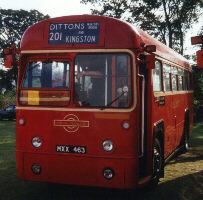
Preserved RF 486 shows the rear arrow arrangement, plus the front trafficators, at Showbus 97.
Photos by Ian Smith. Click for larger versions.
RF retractions
Although the RF and RT both weighed 7.5 ton empty, the RT carried 15 more passengers. So bridge strengthening works in the late fifties and early sixties allowed some heavily used RF routes to be double-decked.
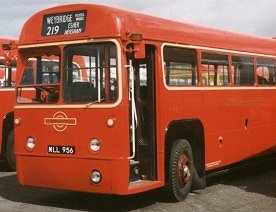 In 1960 the 212 had its RFs replaced by RTs.
This released twenty-one RFs, which went to Kingston to replace TDs on routes 218, 219,
and some 215 workings.
(Route 215A had to wait another 2 years until agreement was reached with the
Traffic Commisioners about using RFs on this route on weekdays.)
In 1960 the 212 had its RFs replaced by RTs.
This released twenty-one RFs, which went to Kingston to replace TDs on routes 218, 219,
and some 215 workings.
(Route 215A had to wait another 2 years until agreement was reached with the
Traffic Commisioners about using RFs on this route on weekdays.)
Further RFs became available when 222 (UX) was absorbed into double-deck 223,
and the 224 group (also UX) became RT operated in May 1962.
Route 213 (NB) also lost its RFs in favour of RTs at the same time.
RF319 with route 219 blinds, Cobham April 98. Click for larger.
Suddenly there was a surplus of red RFs.
The last TDs, at Edgware (240A) and Kingston (215A) vanished,
and some RFs went into store.
The 211 from Southall (HW) also went to double-deckers in 1964 (being extended to Ruislip at the same time), and the 200 from Merton (AL) in 1965.
Some Central RFs were loaned to the Country Area to cover during the 1964-5 overhaul round.
Summary of the early 60's changes:
| Dates | Route No | Route | Garage | Displaced types | Replacements |
|---|---|---|---|---|---|
| January 1960 | 212 | Finsbury Park-Muswell Hill Broadway | MH | RF | RT |
| January 1960 | 215(Sun) | Kingston - Ripley | K | 2TD2 | RF |
| January 1960 | 218 | Kingston - Laleham - Staines | K | 2TD2 | RF |
| January 1960 | 219 | Kingston - Weybridge | K | 2TD2 | RF |
| May 1962 | 222 | Hounslow Central - Uxbridge | UX | RF | RT (on 223) |
| May 1962 | 224,A,B | Uxbridge - Laleham | UX | RF | RT |
| May 1962 | 213 | Kingston - Belmont | NB | RF | RT |
| May 1962 | 240A | Edgware - Mill Hill East | EW | 2TD2 | RF |
| May 1962 | 215A | Kingston - Downside | K | 2TD2 | RF |
| July 1964 | 211 | Ealing Broadway-Ruislip | HW | RF | RT |
| August 1965 | 200 | Wimbledon - Raynes Park | AL | RF | RT |
One Person Operation
The severe staff shortages in the mid-sixties, particularly of conductors, paved the way for agreement on one man operation. This time it was tackled rather more sensitively by management, with a small number of crews affected at a larger number of depots.A side effect was the conversion of some RT routes to RF, and the creation of some new routes.
OPO Route conversions:201 NB Nov 64 206 FW Nov 64 216 K Nov 64 250 NS Nov 64 237 AV Jan 65 251 EW Jan 65 203 AV July65 (Sundays) (new to RF) 20B L Oct 65 (cut from 20): Epping Forest-Loughton 254 L Oct 65 291 BK Oct 65 (cut from 129): Ilford Stn - Barking 215 K Jan 66 215A K Jan 66 264 NB Jan 66 121 EN Aug 66 (new to RF) 234A TC Aug 66 136 HD Aug 66 (new route: Harrow-on-the-Hill and Sth Harrow Stn)
Transfers from Country Area
By the mid sixties all was not well in the Country Area, as bus ridership plummeted. Unrefurbished Green Line coaches had become buses. All their RFs were OMO. Now even modernised RFs were being demoted to bus duties. So now that the Central Area was finding a new need for single deckers, the opportunity was taken to transfer some Country buses to the Central Area. Buses transferred, still green, to Muswell Hill, (MH) on New Year's Day 1969, were: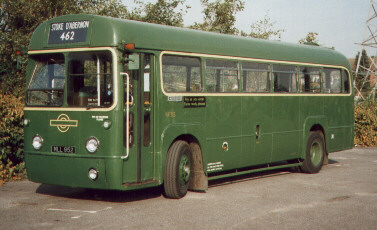
RF 545 NLE 545 RF 563 NLE 563 RF 570 NLE 570 RF 580 NLE 580 RF 598 NLE 598 RF 602 NLE 602 RF 603 NLE 603 RF 608 NLE 608 RF 617 NLE 617 RF 627 NLE 627 RF 632 NLE 632 RF 685 NLE 685
No, RF 315 was NOT one of the transferred Country RFs. Converted for OPO in the Central area in August 1966, it was withdrawn from Fulwell (FW) in February 1973. It has been operated by Memory Lane on Surrey Sunday routes, and private hire, in Country Area livery, as worn by the 1969 transferees for about 6 months. Photo by Ian Smith, at 1997 RF Running Day. Click for larger image.
Further route changes: the Bus Reshaping Plan
In a bid to halt declining public transport use, the Reshaping Plan looked afresh at patterns of travel. Many routes were historical, having been lengthened or abbreviated for one operating reason or another, with seldom a coherent look at the overall pattern. The Plan looked to reshape the network into local feeder services serving trunk route exchange points, which might be railway or bus interchanges. The Central RFs had a part to play in this, particularly on the local feeder services. The part they were actually to play, propping up the new unreliable generation of buses, was not foreseen.In the end historical and local inertia, allied to the rolling stock short-comings, killed off the Re-shaping plan, and the final pattern of RF operations closely resembled the 1950s single-decker situation. One significant difference was the use of RFs for one-person operation on lightly loaded Sunday workings of otherwise double-decked routes, such as the 285.
Withdrawals
The advent of the London Transport Executive in 1970 made little immediate impact. The LTE inherited 233 Central Area RFs (8 more than were originally built!), despite odd casualties. A few were loaned to the fledgling and beleaguered London Country, and worked in red livery from Crawley Garage for some time. More were converted to OPO specification, until by late 1970 there were only 46 left in two-crew format, for use on the 227 (TB) and 236 (D and T). Most of these were called into works in late 1970 for conversion to OPO format, prior to route conversions to SMS Swifts in January and April 1971 respectively. The converted RFs then moved on to Uxbridge for the 204, 223 and 224/B, and the remaining unconverted examples were withdrawn.Aldenham overhauls for RFs restarted in February 1971.
RF385 on the 227. Photo, used with permission, by BusSpotter
The OPO buses continued stalwartly, operating reliably while the new generation came to smoking halts by the roadside, or sagged in the middle when fully loaded (a big problem with centre-exit single-deckers: it stopped the centre doors shutting fully, so the bus could not move!) Many RFs were overhauled in the 1970-1 cycle, but when others came due in 1973 it was decided to withdraw them. Immediate replacements came in the shape of DMS double-deckers and SMS single-deckers. Ninety-five Bristol LHS buses were bought (the BL class), and a large number of standee SMS buses were intended to be modified to properly-seated SMD versions, to act as RF replacements.
The RF was found to be a difficult act to follow, especially in the Kingston area. Some routes (215, 251, 264) should have received SMDs according to the plan, but proved too narrow in practice. Others, like the 212, 254 and 258, allocated BLs, suffered from lack of capacity. Finally, the position of the inspection pits at Kingston prevented the use of larger vehicles there! This meant that either RFs or a larger number of BLs were necessary for the 218 and 219 routes.
Left above: RF 502 on the 218 to Staines (K). Photo, used with permission, by BusSpotter.
Right above: RF 534 in late livery, with extra spotlight for training SM drivers. Photo by Ian Smith.
Right above: RF 486 recreates the 219 atmosphere at Esher during the RF50 celebrations, June 2001.
Enough BLs were not available, so 25 RFs were overhauled in 1977-8 and given 3-year certificates to keep these two services going. The new buses were re-painted too, in the new style with flake-grey trim-lines and white bullseyes in place of the fleetname.
It was the ubiquitous Leyland National that finally killed off the RF. Although also too long for the Kingston garage pits, the Nationals were given a home at Norbiton, to work the 218 and 219 from there.
The RF bowed out from LT passenger service with proper ceremony. Seventeen turned out for the last day of operation, 30th March 1979, with the last run being performed by RF 507, restored to 1953 livery. The following day another three of the class made a commemorative run over the 218 and 219 routes before retiring into Kingston garage.
Some continued for a while with LT as trainers or staff buses, but the rest went mainly for scrap or preservation.
![]()
Surviving Central Area RFs
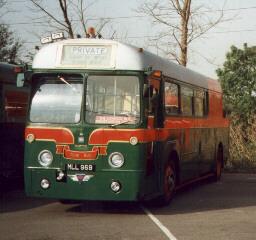 (Please let me know of others that you know about.
(Please let me know of others that you know about.
Thanks to John Hinson for most of this data.)
RF315 MLL 952 RF319 MLL 956 RF326 MLL 963 RF332 MLL 969 towbus RF333 MLL 970 RF337 MLL 974 RF341 MLL 978 RF351 MLL 988 RF354 MLL 991 RF355 MLL 992 RF366 MXX 8 RF368 MXX 10 RF381 MXX 23 RF382 MXX 24 RF383 MXX 25 RF392 MXX 280 RF395 MXX 283 RF401 MXX 289 RF404 MXX 292 RF406 MXX 294 RF415 MXX 392 RF421 MXX 398 RF423 MXX 400 RF429 MXX 406 RF433 MXX 410 RF442 MXX 419 RF444 MXX 421 RF447 MXX 424 RF453 MXX 430 RF457 MXX 434 RF458 MXX 435 RF459 MXX 436 RF462 MXX 439 RF463 MXX 440 RF465 MXX 442 RF468 MXX 445 RF479 MXX 456 RF480 MXX 457 RF486 MXX 463 RF489 MXX 466 RF491 MXX 468 RF495 MXX 472 RF503 MXX 480 RF504 MXX 481 RF507 MXX 484 RF508 MXX 485 RF511 MXX 488 RF512 MXX 489 RF515 MLL 933 RF517 MLL 935 RF518 MLL 936 RF522 MLL 940 RF525 MLL 943 RF530 MLL 948 RF534 NLE 534 RF537 NLE 537 RF538 NLE 538
RF 453 at the East Grinstead Running Day, April 98
Photo by Ian Smith. Click for larger version.
 Bus histories
Bus histories
 Photo Refs
Photo Refs
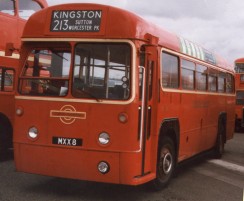
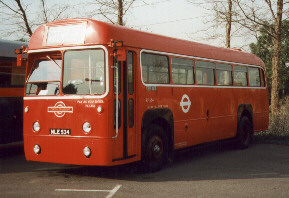
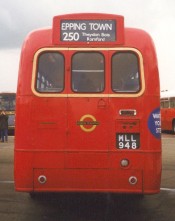
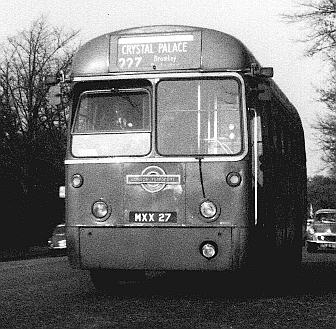

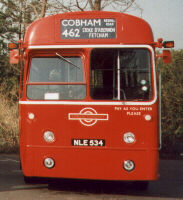

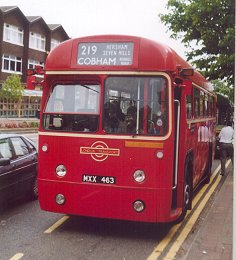
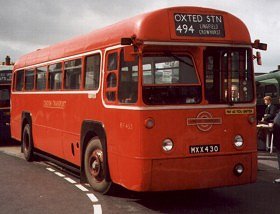
 RF Contents
RF Contents Green Line RFs
Green Line RFs Red RFs
Red RFs